Roux the day: Vintage Jell-O salad in a savory-ish sauce
Is this cheesy orange blob a menace to society?
In case this is your first time visiting the Department of Antediluvian Disquietude and you missed the first installment, this is the latest in a series of Vintage Recipe Roulette reviews using only recipes from Talk About Good, my grandmother’s 1975 community church cookbook. In just 164 pages, this collection of homestyle recipes encapsulates the unlikely intersections of 1800s frontier cuisine, post-war convenience foods, and the mid-century American fetishization of canned chow mein noodles. It is untested, unstandardized, and unmatched in its vintage glory in my opinion. Some of the recipes are amazingly good! And some are amazingly…not. Today, we make an unassuming congealed salad with a saucy secret.
I really thought I knew everything there was to know about Jell-O, from soda to candy to tuna, but this is a new one, y’all, even to me.
There are two orange Jell-O salads in my grandmother’s cookbook that are very similar, and I’ve decided to take inspiration from both:
The congealed salad itself is pretty standard — a total of 6 oz. of Jell-O powder, pineapple and bananas, and mini-mallows. One version uses the mid-century obsession with putting soda in everything. I’m using all orange Jell-O so I can show you their swanky new label, and I’m dicing instead of mashing (eww) the bananas, and I’ve counted out 40 mini marshmallows instead of measuring, because it’s hilarious.
I’m using soda, too, and it’s important to note that the liquid in that version is reduced, because the acid in the soda interferes with gelling. It’s also helpful to use crushed or small diced fruit, because big pieces increase the likelihood that your mold will separate around them and tear. It’s important to chill the gelatin until it’s a thick jelly consistency, lest your fruit sink to the bottom and your marshmallows float to the top, like a layer cake from hell. This one came out great with just a little fussing over it!
There’s no shame in using a 9x9 pan, though, and serving in squares. My grandmother often did for non-holiday use. That also lets you use big chunks of banana or berries or, you know, tuna with whole olives.
What’s really unusual here is the saucy topping, with ingredients that are a hybrid of sabayon and Greek bechamel, except that the wine or cream is replaced with pineapple juice, and the second version tops with grated cheese! (Yes, of course I am making that one.) I am very, very worried about the directions. Upon first reading, since community recipes often leave out steps, I assumed one would make a roux to prevent lumps, but upon closer reading, I realized the recipe specifically says to combine the first four ingredients. I’m also extremely concerned about the addition of a whole egg rather than an egg yolk — even with a double boiler, which it doesn’t call for, the potential here for scrambled pineapple juice is extremely high.
Once your cursed bechamel is made, of course, you add that magic 1960s genuine stabilized whipped-cream facsimile, Cool Whip, whose old jingle is a triumph of camp:
Cool Whip’s main claims to fame over the years have included words like “surprisingly light”, “already whipped”, and “non-dairy”. It isn’t prone to spoiling, melting, or breaking like whipped cream, making it a no-brainer for an era when appearance was elevated as much as flavor (maybe more), and it’s pre-prepped. The main ingredients are trans fat, high fructose corn syrup, a bunch of technically non-toxic chemical stabilizers, and…milk, cream and casein (one of the two main milk proteins)? Then how can they call it non-dairy?
The Merriam-Webster begs to differ, but the food labeling term “non-dairy” arises from a beef (pun very much intended) between the dairy industry and the burgeoning food-like substance processing industry. As things like processed cheese food and powdered coffee creamer made from isolated caseinate came on the market, producers and purveyors of natural milk and traditional cheese understandably wanted to draw a distinction, both in terms of flavor and nutrition. Since food allergy was much less common at the time, the labeling focus was on making sure the consumer understood those items weren’t their grandmother’s dairy aisle standards, but instead were extended with other, less nutritional ingredients, and there was no attention paid to whether it contained refined components of milk.
The upshot is that non-dairy creamer, non-dairy soft-serve ice cream, and non-dairy whipped topping all contain at least some components of milk…they just aren’t made from dairy milk as the main ingredient. This is a major issue in the food allergy community, and the labeling is still getting figured out, with new labeling regulations over so-called PBMA, plant-based milk alternatives, too. The dairy industry remains plenty hot about it, and further changes are likely. Stay tuned.
Today, I’m using one that’s called Coco Whip, a dairy-free (not non-dairy…got that?) topping made by PBMA titan So Delicious, really just because I’ve always wondered what it’s like. I often have patients with dairy allergy or fructose intolerance, and it’s nice to be able to tell them about fun things they can have. Dietary restrictions can feel pretty heavy if you have to give up a lot of convenience along with the things you love. This one is based on coconut oil and real sugar, with a little pea protein for stabilizing, and some of the usual weird chemicals, but it looks pretty close to the real thing, and it doesn’t taste coconutty.
But…the base for this sauce, y’all. It’s so interesting to me that a relatively humble gelatin recipe requires making any kind of custard sauce, but I’ll admit it’s a welcome change from the usual mayonnaise fluff…unless it’s a disaster. One version says to combine the flour, beaten egg, sugar, and juice, and “cook until thick”, then add the oleo (oleo (just a vintage word for margarine, and I’m using a trans-fat-less vegan one). The other says to combine everything, and cook the same way. If you want to try to make it, mix the flour and sugar together first, making sure there are no lumps, and then add the egg and stir thoroughly before adding the juice and heating. As for me, I am petrified that this is going to be a lumpy mess, and if it clumps up, I’ll have to go get more pineapple juice on a Sunday morning. I love you, dear reader, but not that much. I’ve decided to make a roux anyway, cooking it just a couple of minutes to prevent browning but ensure lump-free goodness. I scrambled the bejeezus out of the egg and mixed it with the sugar to try to really get it emulsified. I risked cooking it on the stovetop but on veryveryvery low heat, and there were still a couple of weird stringy white bits. Yick. I think this is extremely likely regardless of how carefully you make this sauce, which is why approximately 0% of other custard sauce recipes use the egg white. I strained it, and then stirred in the Coco Whip. It’s smooth and pineappley, but this is a lot of work for a pudding-like, not at all decorative sauce.
You can’t pipe this stuff, so I elected to spoon it on top so that it could glop artfully down the sides, and it obliged. I reserved some for serving. And yes, of course I put cheese on it. You’re going to think I’m nuts, but my grandmother used to make the infamous Southern pear-mayo-cheddar salad, and it wasn’t half bad.
This mold is a real behemoth, piled high with grated definitely real dairy cheese and pineapple sabayon-Cool Whip sauce. I think it may have won the 1952 Helsinki Olympics shotput.
But how does it taste? I could do without the marshmallow even though there are only 40 of them. They have a mouthfeel like SpongeBob, who lives in a pineapple gelatin salad under the sea. And I don’t think the soda added anything at all. Aside from that...it’s pretty good. The cheese is welcome — it enhances the other flavors rather than detracting, just adding a little complexity rather than making it taste like Velveeta. If you’ve ever had apple pie with a cheddar crust (and you should), you’ll know what I mean.
It looks like someone boiled down the happy parts of the 1960s into some kind of aggressively cheerful funhouse lampshade, but the flavors and textures work well. Looking for a fun holiday salad for nostalgia purposes? This might be the one. If I ever make it for a retro dinner party or some such, I think I will reduce the pineapple juice down to 1/3 c or so, thicken with a teaspoon of arrowroot powder, and mix it with real stabilized whipped cream for a more controllable but still unique, flavorful, and melt-resistant topping.
And yes, I will use the cheese! I’m gonna skip the SpongBob bits, though.
Zen and the Science of Candy Corn is a reader-supported publication that brings me great joy. You can literally give me your 2 cents with the tip jar button below!
Of course, if you’d like to subscribe, free or paid? That would be heavenly.
And please feel free to share this post with any cement cake-loving psychopaths you know.




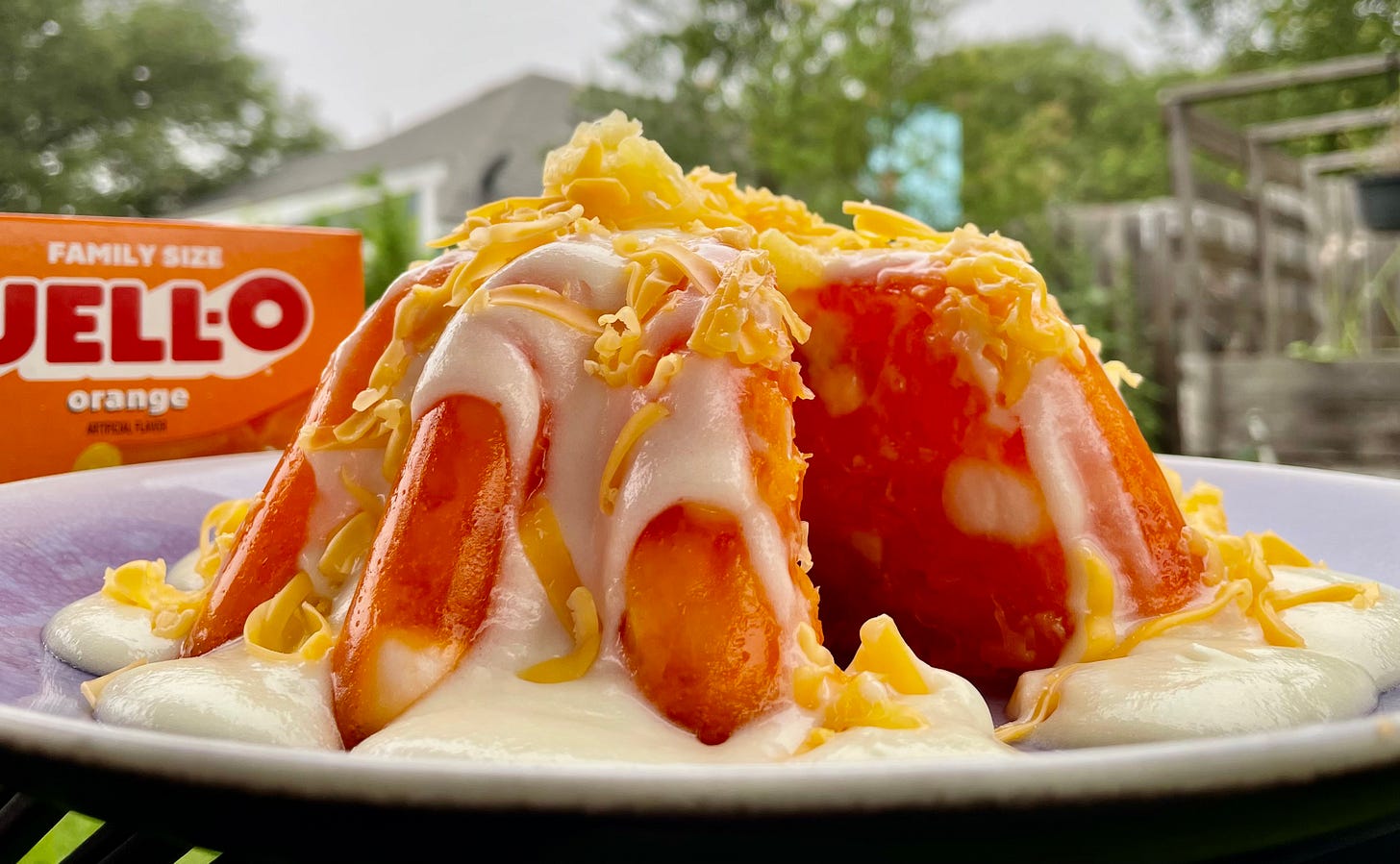

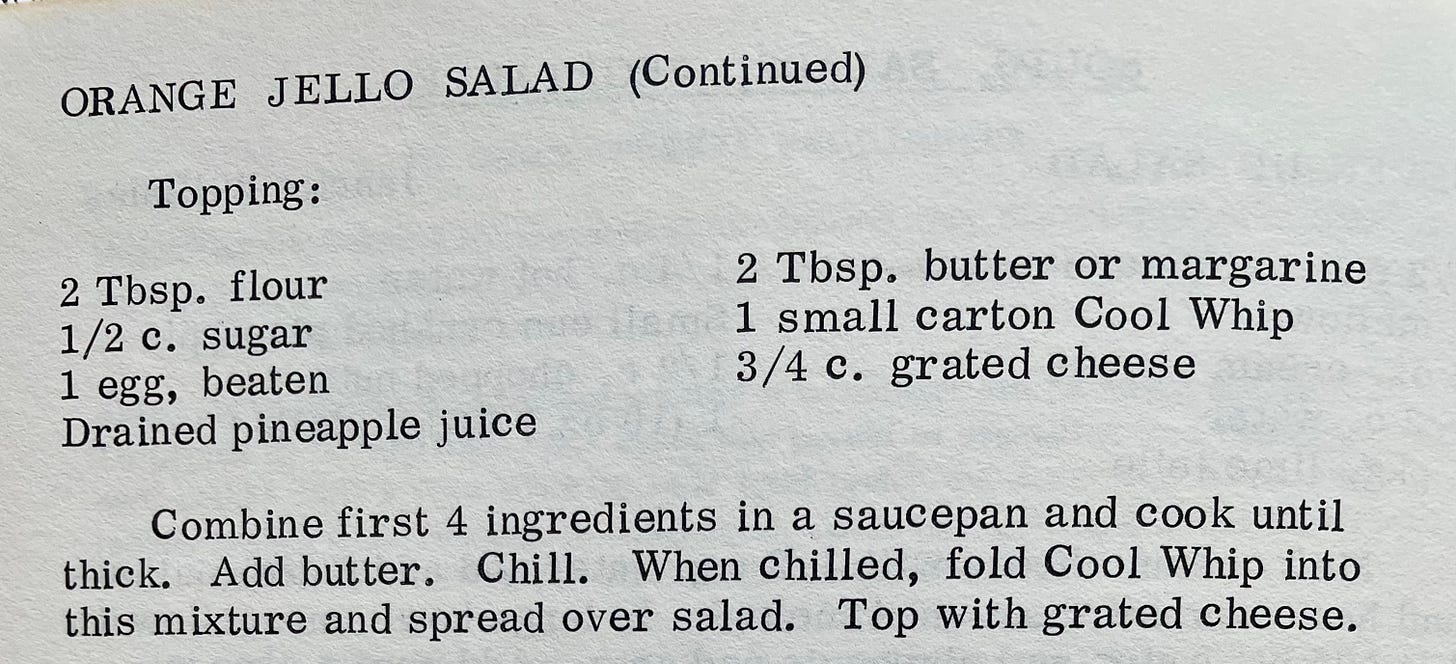
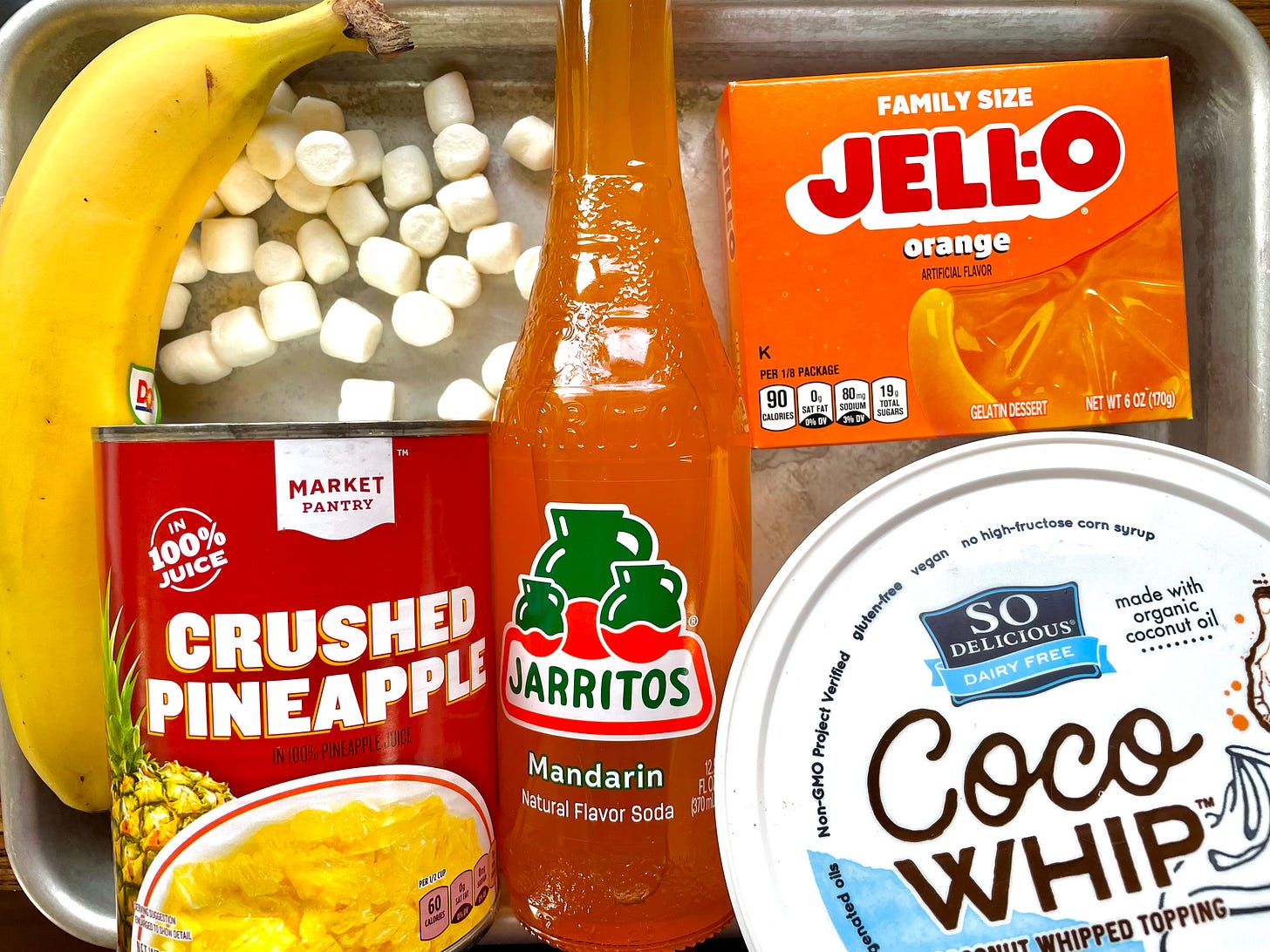
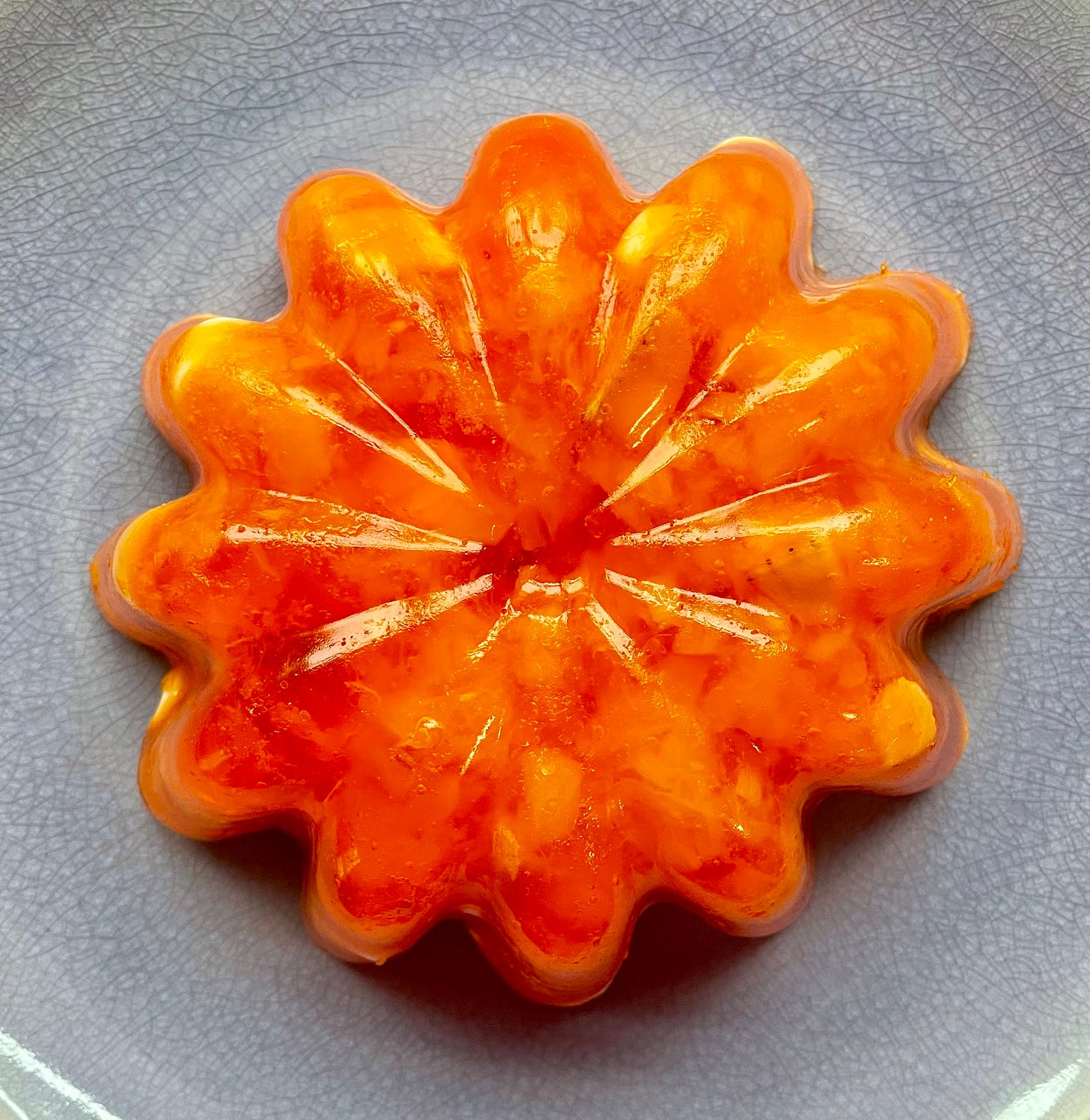
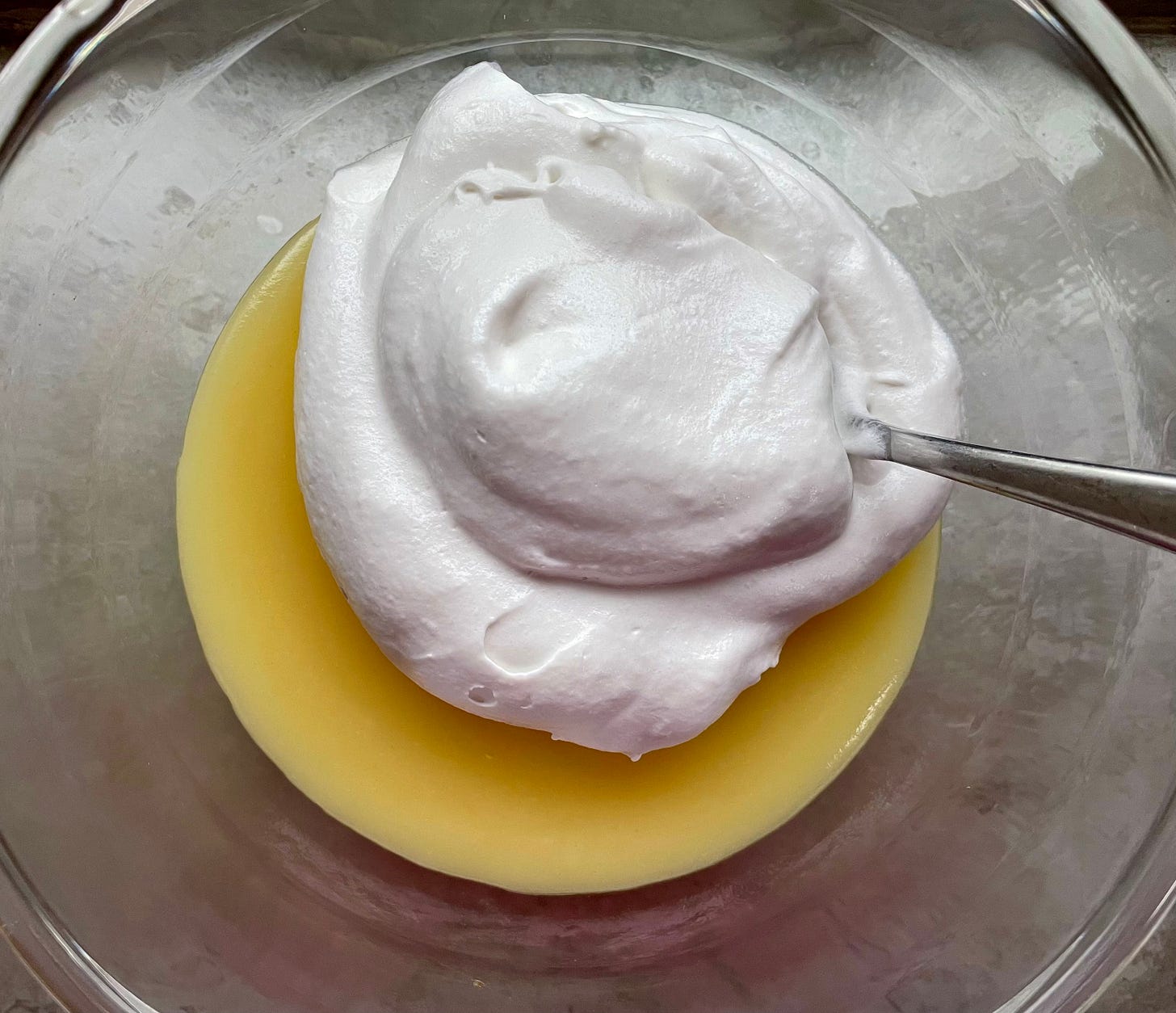
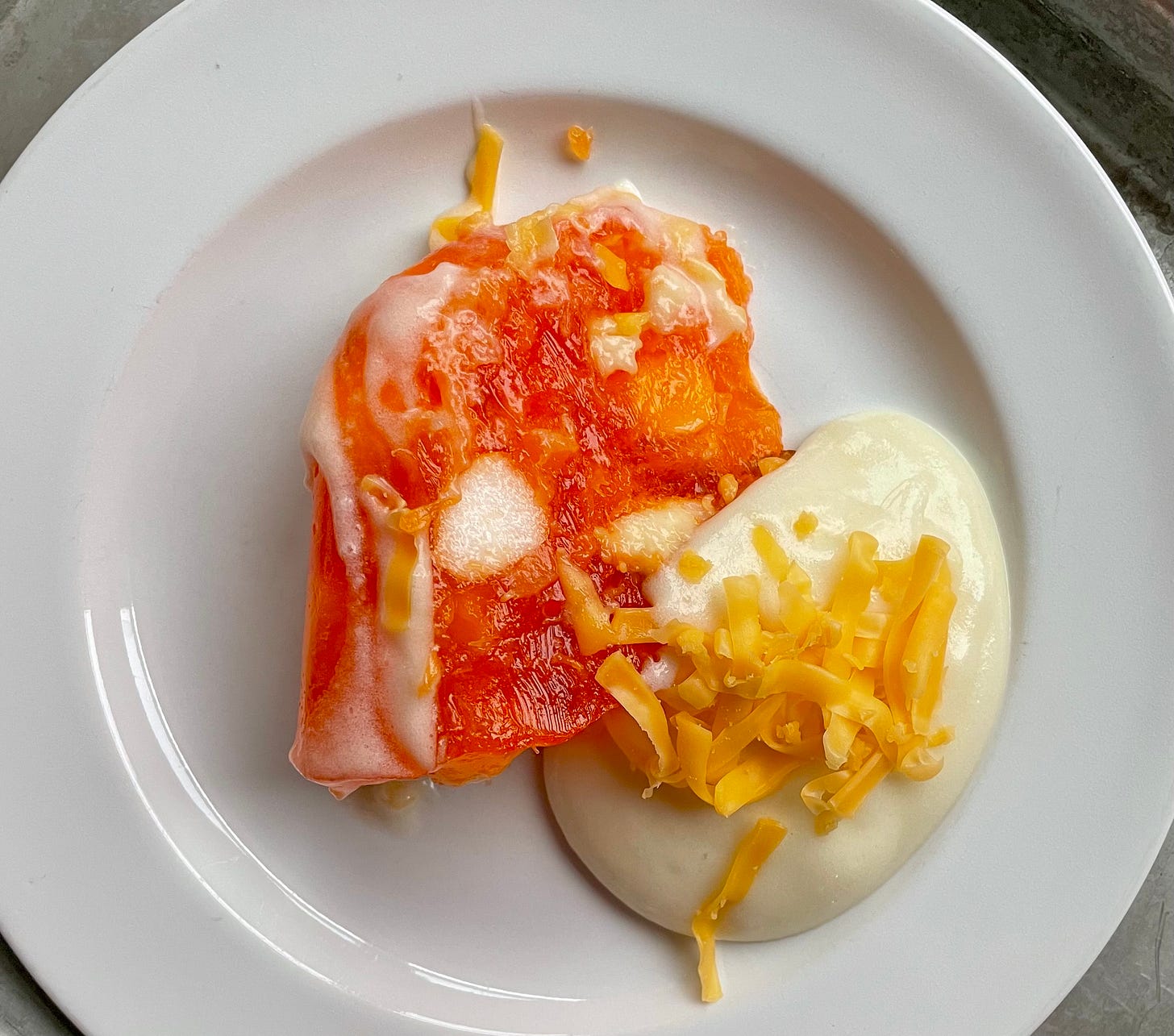
This recipe has slid past “who hurt you” right into Stockholm Syndrome.
This looks nice